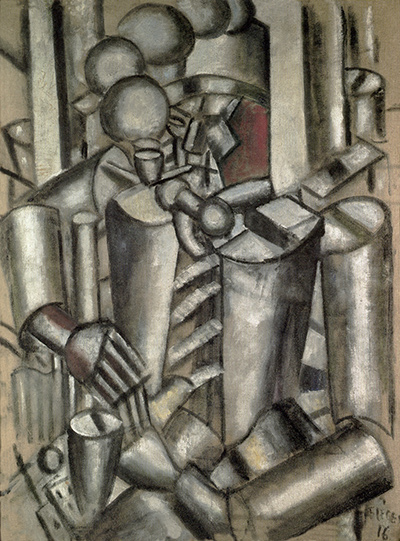Soldier with a Pipe is a cubist painting by Fernand Leger from 1916, during his spell in military service. The original can now be found at the Kunstsammlung Nordrhein-Westfalen, Düsseldorf in Germany.
Leger was restricted during his time in WWI because of a lack of availability of resources and he was therefore forced to mainly work on his drawings. He likely would have produced several sketches in preparation for this painting, persuading his colleagues to pose during a rare moment of peace. This form of Cubism is very much the signature style of Leger, with some terming it Tubulism. The colour scheme is dark and depressing, communicating the sad environment in which these servicemen worked. It is also the case that Leger was an artist who concentrated most on form rather than colour, perhaps under the influence of Cezanne.
The original title was Le Soldat à la Pipe and this painting is sized at 130cm tall x 97cm wide. Fernand Leger used dark outlines to produce his forms, and then heavy gradients of colour which filled them. There is a little use of red, but the vast majority of the painting is essentially in grayscale. It can take a little time and concentration to find the items in the painting as described in the title. The pipe sits centrally, just above the elongated torso of the soldier. Small circles are placed to symbolise smoke clouds that eminate from the pipe. The two arms and hands of the soldier are perhaps the easiest elements to make out.
The Kunstsammlung Nordrhein-Westfalen in Düsseldorf holds a fine collection of paintings, drawings and all manner of other mediums. Besides the works of Leger that can be found there, you will also see original artworks from other notable artists such as Ernst Ludwig Kirchner, Franz Marc, Paul Klee, Georges Braque and Juan Gris. The institution opened in 1961 but has undergone several major revamps in the years that have passed since then. The focus on contemporary artists such as this should enable the venue to attract significant numbers from the younger generations who generally prefer art from the 20th century. Those with a more wider scope of interest will still also fancy seeing some of these great names too, with Cubism still being seen as a key element to the success of contemporary art. Düsseldorf itself also features a wide selection of cultural activities aside from this to reflect the importance of this city within the nation of Germany.
Fernand Leger would produce a style of Cubism that would become termed Tubism, because of the shapes that he would use within his paintings for a period of his career. It is that style for which he would become most famous, but in truth his oeuvre was actually much more varied than just that. He also went far beyond just paintings and drawings, moving into book illustration and costume and theatre set design later in his career as he sought out new challenges. There were also a number of sculptures as well. This was clearly an artist who wanted to achieve something unique within his career and so challenged himself across both different styles as well as mediums over an extended period. His life would cross both world wars and yet he was still able to leave such an impactful life behind by the time of his passing in the 1950s.




